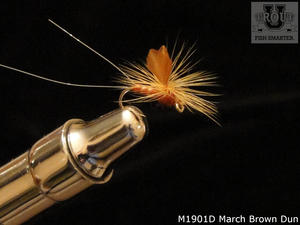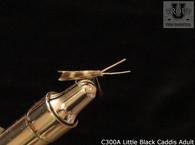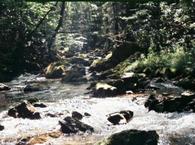
In our most recent blog we discussed nymphing tactics with the Hendrickson Mayfly. However, it may be worthwhile to discuss some of the more basic fundamentals of the Mayflies life cycle.
EGGS:
Shall we start with the female adult laying eggs after having mated. Some species of Mayflies release their eggs high in the air (bombers), some release their eggs as they float on the water (floaters), some land on the water release a few eggs, then take off (landers), while still others fly low over the water and dip the tips of their abdomen below the surface of the water to lay their eggs (dippers).
NYMPHS:
Regardless of how the eggs are layed, the eggs hatch in usually 2 or 3 weeks and start the next cycle as nym phs. The nymphs are the young, underwater stages of the mayfly’s life cycle, and they are covered by hard exoskeletons. They can live in the nymph stage for as long as 3 months and even up to a year in some species. During this time they are growing but the hard exoskeleton does not grow with them. Consequently,they grow a new exoskeleton underneath and shed the old smaller exoskeleton which can no longer house them. This process is called the molting stage or instar.
phs. The nymphs are the young, underwater stages of the mayfly’s life cycle, and they are covered by hard exoskeletons. They can live in the nymph stage for as long as 3 months and even up to a year in some species. During this time they are growing but the hard exoskeleton does not grow with them. Consequently,they grow a new exoskeleton underneath and shed the old smaller exoskeleton which can no longer house them. This process is called the molting stage or instar.
 phs. The nymphs are the young, underwater stages of the mayfly’s life cycle, and they are covered by hard exoskeletons. They can live in the nymph stage for as long as 3 months and even up to a year in some species. During this time they are growing but the hard exoskeleton does not grow with them. Consequently,they grow a new exoskeleton underneath and shed the old smaller exoskeleton which can no longer house them. This process is called the molting stage or instar.
phs. The nymphs are the young, underwater stages of the mayfly’s life cycle, and they are covered by hard exoskeletons. They can live in the nymph stage for as long as 3 months and even up to a year in some species. During this time they are growing but the hard exoskeleton does not grow with them. Consequently,they grow a new exoskeleton underneath and shed the old smaller exoskeleton which can no longer house them. This process is called the molting stage or instar.
Anglers are aware of four stages of nymphs which are swimmers, clingers,crawlers and burrowers. The swimmers includes the Baetidae family (Blue Winged Olives) and are so named because they swim very fast and dart about in the water. The clingers or Heptageniidae family which includes the March Browns, Cahills and Quill Gordons have strong legs and claws that enable them to cling to the rocks.
The crawlers include the Hendricksons, the Pale Morning Duns, and the Sulphers from the Ephemerella genus and they are not good swimmers or clingers so they have to resort to the lowly art of crawling. The burrowers including the Ephemeridae and the Polymitarcyidae are nocturnal insects that create burrows in the silt on the river bottoms. They are easily identified by their long yellow bodies. The Hexagenia Limbatas commonly referred to as "Hex" are good examples of these and their hatch on streams like the Mossy Creek in Virginia looks like a snowstorm because the air is so dense with them.
DUNS:
 The "hatch" or emergence occurs when the nymph breaks out of its exoskeleton and becomes an adult winged stage of the insect called duns. This can happen in one of three ways and usually takes place within an hour or two. Most often the method of emerging is with the nymph swimming to the water surface and breaking out of the exoskeleton. Sometimes they may drift in the water for 200 or even 300 feet before they shed their shuck making them extremely vulnerable to hungry trout. After the dun wiggles out of the exoskeleton and onto the surface of the water, it will float along waiting for the wings to dry out. This process is referred to by anglers as the "hatch" however in scientific terminology it is a metamorphosis. This is the dry fly angler’s opportunity that he has been waiting for.
The "hatch" or emergence occurs when the nymph breaks out of its exoskeleton and becomes an adult winged stage of the insect called duns. This can happen in one of three ways and usually takes place within an hour or two. Most often the method of emerging is with the nymph swimming to the water surface and breaking out of the exoskeleton. Sometimes they may drift in the water for 200 or even 300 feet before they shed their shuck making them extremely vulnerable to hungry trout. After the dun wiggles out of the exoskeleton and onto the surface of the water, it will float along waiting for the wings to dry out. This process is referred to by anglers as the "hatch" however in scientific terminology it is a metamorphosis. This is the dry fly angler’s opportunity that he has been waiting for.
However, some species will emerge several feet underwater and swim to the surface. When this occurs, the angler should consider using a "wet dun" pattern. Other species of mayflies will crawl out of the water while it is still in the nymph stage and it will emerge on the rocks or logs along the banks of the stream or on the stems of plants. When this occurs, the angler will be wise to use the nymph pattern as it will not be possible to use a dun imitation since they are not over the water as a rule.
SPINNERS:
 Within a period of one or two days the dun will molt into the mature adult stage known as the "spinner". After molting, the spinners will usually gather in swarms over the water to mate. Some mayflies will fall dead or "spent" after mating but most other species will lay eggs to start the cycle all over again. The spinner falls usually happen at dusk and usually above the riffles. However, the spinners are the most unpredictable stage of the cycle so the key word here is usually.
Within a period of one or two days the dun will molt into the mature adult stage known as the "spinner". After molting, the spinners will usually gather in swarms over the water to mate. Some mayflies will fall dead or "spent" after mating but most other species will lay eggs to start the cycle all over again. The spinner falls usually happen at dusk and usually above the riffles. However, the spinners are the most unpredictable stage of the cycle so the key word here is usually.




